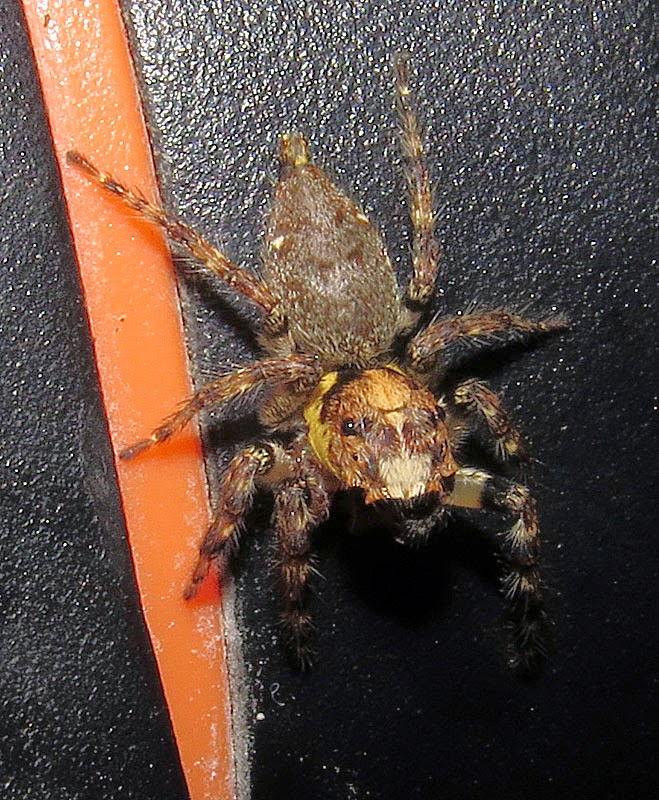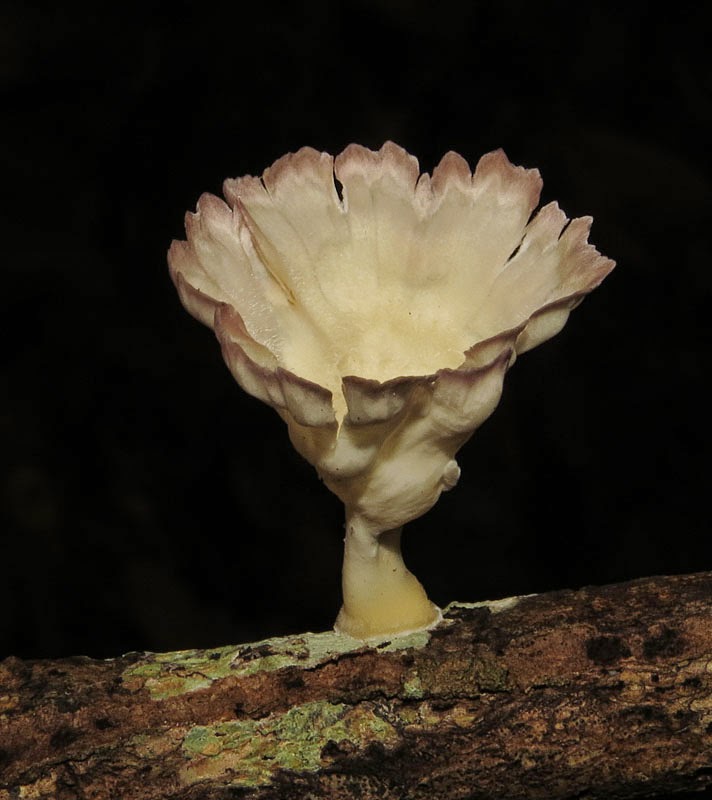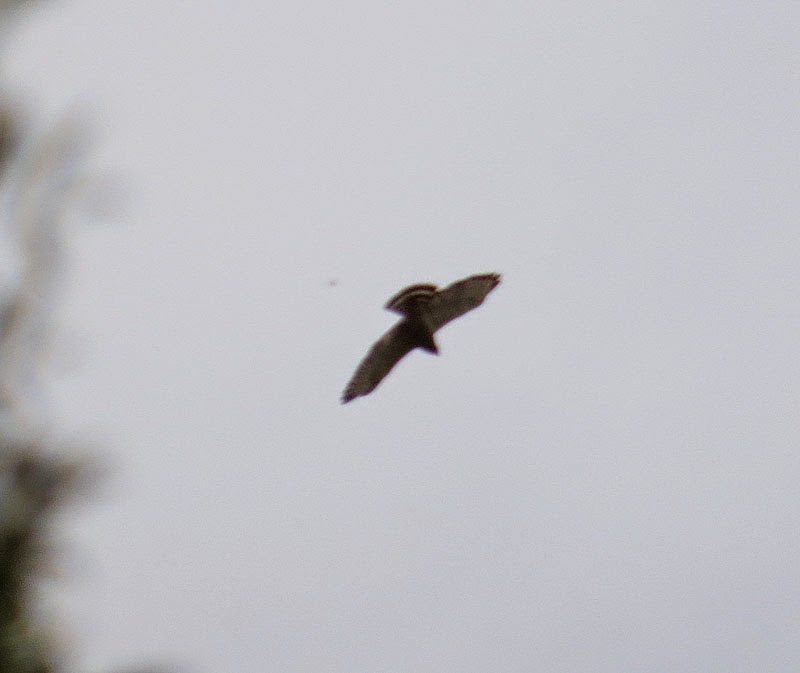A short visit from one of my oldest
friends from Oregon, Alan Contreras, was a perfect excuse to go
birding. We planned to go birding a bit Thursday morning, followed by
a small homemade pizza and wine party with a few friends of mine, but
a howling gale kicked up, as forecasted, Wednesday night and
continued all day Thursday. So we postponed birding until yesterday. Here's Alan on the right, with friends DuWane (you can see his hands), Jack, Manabu, Andrew, and Hal enjoying the pizzas they each made.
Without too much difficulty we found
our primary target, this Sinaloa Wren, along the Anza Trail south of
the town of Tubac.
This bird is one of only two
individuals of this species known to be in the United States at this
moment, and the species first occurred in this country just six and a half years
ago. Up until then it was known strictly from Mexico, but breeding
was known to occur as close as 30 miles from Arizona, and several
people suspected it would eventually show up here. The scenario
explaining its arrival – as well as its rarity here – is rather
easy to surmise, and very closely matches that of Black-capped
Gnatcatcher and Rufous-capped Warbler. Each species has its own
precise habitat requirements, but all three are common, non-migratory
residents in western Mexico well up into northern Sonora where their
habitat is continuous but comes to an abrupt stop not far south of the US border. North of there one
is met with higher, drier elevations as well as the increasing
influence of temperate weather systems. But bits and pieces of their
preferred habitats do occur to the north, once you get over that last
ridge and drop into the uppermost stretches of the Santa Cruz-Gila
River drainage on our side of the border and find yourself in the
most protected and well-watered canyons and riparian areas. So when
individual birds at that bleeding northern edge of the continuous,
appropriate habitat are forced out of their natal territories to go
set one up of their own, only to the south will they find more
habitat. But they don't know in which direction to disperse, and any
that try to wander north will find themselves in uncomfortably open, exposed situations, probably unable to find food or hide from
predators. So they probably just have to keep moving. Many of these
dispersing birds probably die, but some, perhaps those with just a
bit more wanderlust than the average, get lucky and find those
pockets of habitat in Arizona.
The first Sinaloa wren was found along
Sonoita Creek in Patagonia on August 25, 2008 by Matt Brown and
Robin Baxter, and that bird stuck to that territory for at least 15
months. The bird that Alan and I saw yesterday was found by David
Stejskal on September 11, 2013, and theoretically could be the same
bird that gave up on finding a mate in Patagonia and wandered about
30 miles downstream to its current location. But unless it's singing, most birders would
overlook this bird, and it's even possible that four or five are
living in obscurity up and down Sonoita Creek and the upper Santa
Cruz River.
The second bird known from the United
States was found on April 14, 2009 by Diane Touret in Huachuca
Canyon, near Sierra Vista. Many birders reported not being able to
find it after April 18 that year, and with the Patagonia bird being
easier to find, few birders ever returned to Huachuca Canyon. But Ron
Beck and friends found one in the same general area on September 2,
2013 – just 9 days before Dave found the one by Tubac. And it
should be mentioned that both of these birds were discovered because
they were singing. Each could have been there for months (and it only
seems obvious that the Huachuca Canyon bird had actually been there,
undetected, for the previous 3 years and 4 ½ months), but perhaps
the species has a quiet period during the mid-summer months, with an
upsurge in singing activity in September.
Bird activity was actually pretty high
along the 50-yard stretch of the Santa Cruz River while Alan and I
walked back and forth hoping to get good views of the wren. I had
birded this spot last April with my friend Anthony Collerton (but
missed the wren then), and on the very same power poles then was
probably this very same Common Raven who seemed to be uttering what I
would refer to as a “song.” Here's my recording of it:
As Alan and I drove back north to
Tucson to bird some other areas, I mulled around in my mind what
spots might be interesting, and almost at the last minute decided on
Sam Lena Park, also known as the Keno Environmental Restoration
Project (KERP). It used to be merely an unmarked, unfenced, and
untended catchment basin for runoff, and in the late 1990's was a
fabulous place for birding. Then the city decided to “improve”
it, and while there has been some recovery, access is limited, with
fences and warning signs, and it just isn't as attractive as it used
to be (plus, it's a 9.5-mile bike ride from home, and back then I
owned a car). Nevertheless, there is a lake that is largely visible,
and any body of water in the desert has potential. The first surprise
as we arrived was the largest group of Neotropic Cormorants I have
ever seen in southern Arizona. I counted 70, amongst which was one
Double-crested. This appears to be a recent influx, with other eBird
reports from the past few weeks mostly being fewer than 30 birds.
This is a recent phenomenon that is only three years old – the
arrival of dozens of Neotropic Cormorants into the Tucson area during
January and February, when they now far outnumber Double-crested
Cormorants. A quick check of eBird data for the months of January and
February show a few were here in 2010, but in 2009 and 2011 none were
reported.
We birded along the edge of the
reservoir and the inlet arm, first coming across this pair of Greater
Roadrunners. The male seemed to be trying to impress the female with
his blue, white, and red postocular skin exposed and engorged with
pigments.
We pished and tooted a few times, bringing in
Orange-crowned Warblers, Yellow-rumped Warblers, Anna's Hummingbirds,
a scarce Tucson city-limit Hermit Thrush, and this colorful Cassin's
Vireo.
When we returned to the car, the
cormorant flock had been joined by this Snowy Egret, a very scarce
bird here in the winter, with only three having been spotted on the
Tucson Valley Christmas Bird Count.






















































